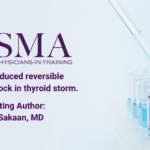Abstract | May 5, 2021
Diltiazam induced reversible cardiogenic shock in thyroid storm
Abstract:
Early recognition of underlying thyroid disease in patients presenting with new onset tachyarrhythmia’s is central to management, as usual rate-control strategies can result in significant mortality and morbidity. Hyperthyroidism induced cardiomyopathy complicated by cardiogenic shock is a life threatening condition. Thyroid storm can lead to irreversible cardiovascular collapse and death if proper treatment is not initiated as soon as possible (1). In this case, we report a previously healthy 44-year-old female with a past medical history of anxiety who presented to the ED with complaints of anxiety and palpitations, and symptoms of early menopause. An (ECG) in the ED demonstrated (A. fib) with (RVR) felt to be secondary to thyroid storm based on the Burch-Wartofsky point scale (2). The patient was initially managed with a continuous infusion of Diltiazem. Shortly after initiating the infusion, the patient developed signs and symptoms consistent with cardiogenic shock. Bedside echocardiogram revealed an estimated (EF) <10% with concomitant pulmonary edema. Repeat echocardiogram Within 72 hours after stopping Diltiazem and starting appropriate treatment for thyroid storm showed improvement of EF to 35%.
Learning Objectives:
- The diagnosis of thyroid storm is based on clinical criteria alone. Therefore, maintaining high clinical suspicion when laboratory evidence is suggestive of thyrotoxicosis is paramount in guiding clinical management.
- Burch and Wartofsky is one of the scoring systems originally developed in 1993 in an effort to delineate thyroid storm and thyrotoxicosis. The system is based on vital signs, symptoms, and cardiovascular condition.
- Once diagnosed, guidelines suggest that patients with tachyarrhythmia be immediately started on beta-blocker (i.e. propranolol typically 60 to 80 mg orally every 4-6 hours) to maintain heart rate below 90, in addition to thionamide “propylthiouracil” (PTU) 200 mg every 4 hours or methimazole 20 mg orally every 4-6 hours). Also, saturated solution of potassium iodide 5 drops orally every six hours or Lugol’s solution 10 drops every eight hours should be started 1 hour after starting thionamide to prevent the iodine from being used as a substrate for new hormone synthesis in patients with toxic adenoma or toxic multinodular goiter . Depending on patient’s condition and severity of thyroid storm, administration of glucocorticoids (hydrocortisone 100 mg IV every 8 hours) or cholestyramine 4 g orally 4 times daily can be beneficial in patients with severe presentations to reduce enterohepatic recycling of thyroid hormone

